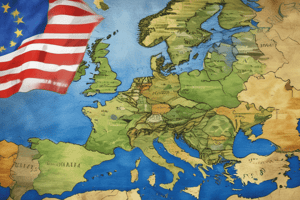Podcast
Questions and Answers
What was the primary goal formulated by European politicians in 1945?
What was the primary goal formulated by European politicians in 1945?
- To end war and prevent future conflicts (correct)
- To establish a centralized government
- To create economic partnerships
- To foster military alliances
Which countries were the founding members of the European Coal and Steel Community (ECSC)?
Which countries were the founding members of the European Coal and Steel Community (ECSC)?
- Germany, France, Italy, Belgium, Netherlands, and Luxembourg (correct)
- Germany, France, Italy, and Luxembourg
- Austria, Belgium, France, and Italy
- France, Italy, Spain, and Portugal
When did the United Kingdom officially leave the European Union?
When did the United Kingdom officially leave the European Union?
- January 31, 2020 (correct)
- January 31, 2018
- June 24, 2016
- December 31, 2020
What significant enlargement of the EU occurred in 2004?
What significant enlargement of the EU occurred in 2004?
What does 'candidate status' refer to in the context of countries wanting to join the EU?
What does 'candidate status' refer to in the context of countries wanting to join the EU?
What was a notable consequence of the UK's decision to leave the EU?
What was a notable consequence of the UK's decision to leave the EU?
Which country joined the EU last as of the information provided?
Which country joined the EU last as of the information provided?
What major event occurred concerning EU membership in 2016?
What major event occurred concerning EU membership in 2016?
Flashcards
What is the ECSC?
What is the ECSC?
The European Coal and Steel Community (ECSC) was established in 1951 to control coal and steel production in Germany and France, aiming to prevent future wars through economic cooperation.
What is the EEC?
What is the EEC?
The European Economic Community (EEC) was formed in 1957 by the same six countries that established the ECSC, expanding economic cooperation beyond coal and steel.
What is the EU?
What is the EU?
The European Union (EU) is a political and economic union of European countries that started with the EEC and has expanded to include many members.
When did Austria join the EU?
When did Austria join the EU?
Signup and view all the flashcards
What is the 'Eastern Enlargement'?
What is the 'Eastern Enlargement'?
Signup and view all the flashcards
What is 'Brexit'?
What is 'Brexit'?
Signup and view all the flashcards
What is the process for becoming an EU member?
What is the process for becoming an EU member?
Signup and view all the flashcards
What challenges does the EU face regarding expansion?
What challenges does the EU face regarding expansion?
Signup and view all the flashcards
Study Notes
The Formation and Expansion of the European Union
- The European Union (EU) aimed to prevent another war after World War II
- In 1945, politicians aimed to create a union where member states would not resort to conflict.
- The European Coal and Steel Community (ECSC) was founded in 1951, involving several countries including Germany, France, Italy, Belgium, the Netherlands, and Luxembourg
- The ECSC's goal was to merge the coal and steel industries of member countries
- Six years after, the countries signed the "Treaty of Rome," forming the European Economic Community (EEC)
- The EEC combined the ECSC and other communities
- The EEC later evolved into the European Union
- The EU aimed initially to remove trade barriers between its members
- This led to the abolishment of tariffs
- The subsequent expansion included countries like Denmark, Ireland, and the UK, further increasing collaborations
- The enlargement included Greece, Spain, and Portugal
- A significant expansion in 2004 brought in 10 new countries
- This included Czech Republic, Slovakia, Slovenia, Hungary, Cyprus, Malta, Poland, Estonia, Latvia, and Lithuania
- Bulgaria and Romania joined in 2007.
- Croatia became the 28th member in 2013
- The UK's departure, or Brexit, occurred in 2020.
- The EU continues to face challenges concerning the number of countries that can be incorporated into the union and political disagreements
- There are still several countries that want to join the Union, like Turkey, which has been involved in negotiations for a long time but has seen delays.
Studying That Suits You
Use AI to generate personalized quizzes and flashcards to suit your learning preferences.



